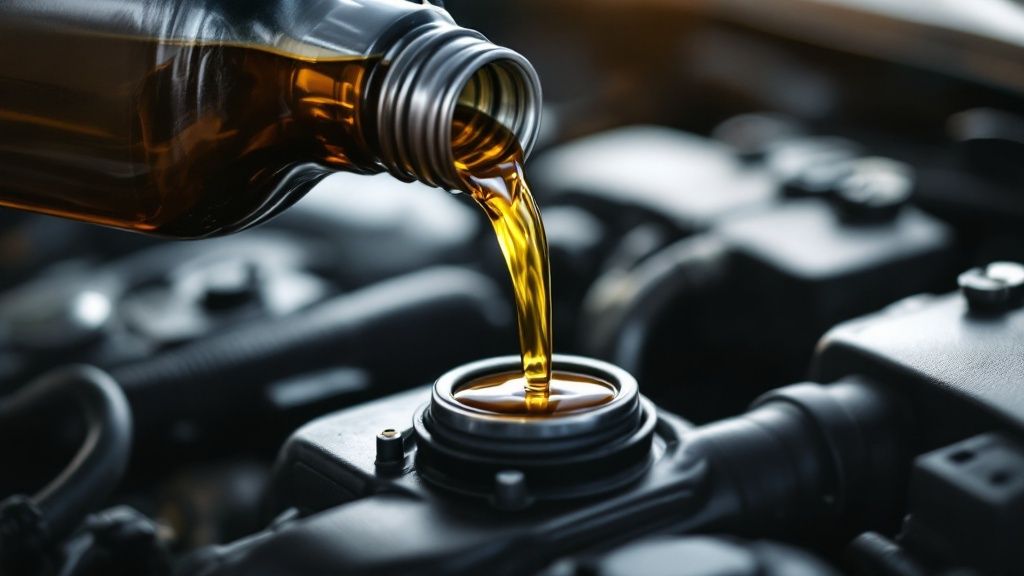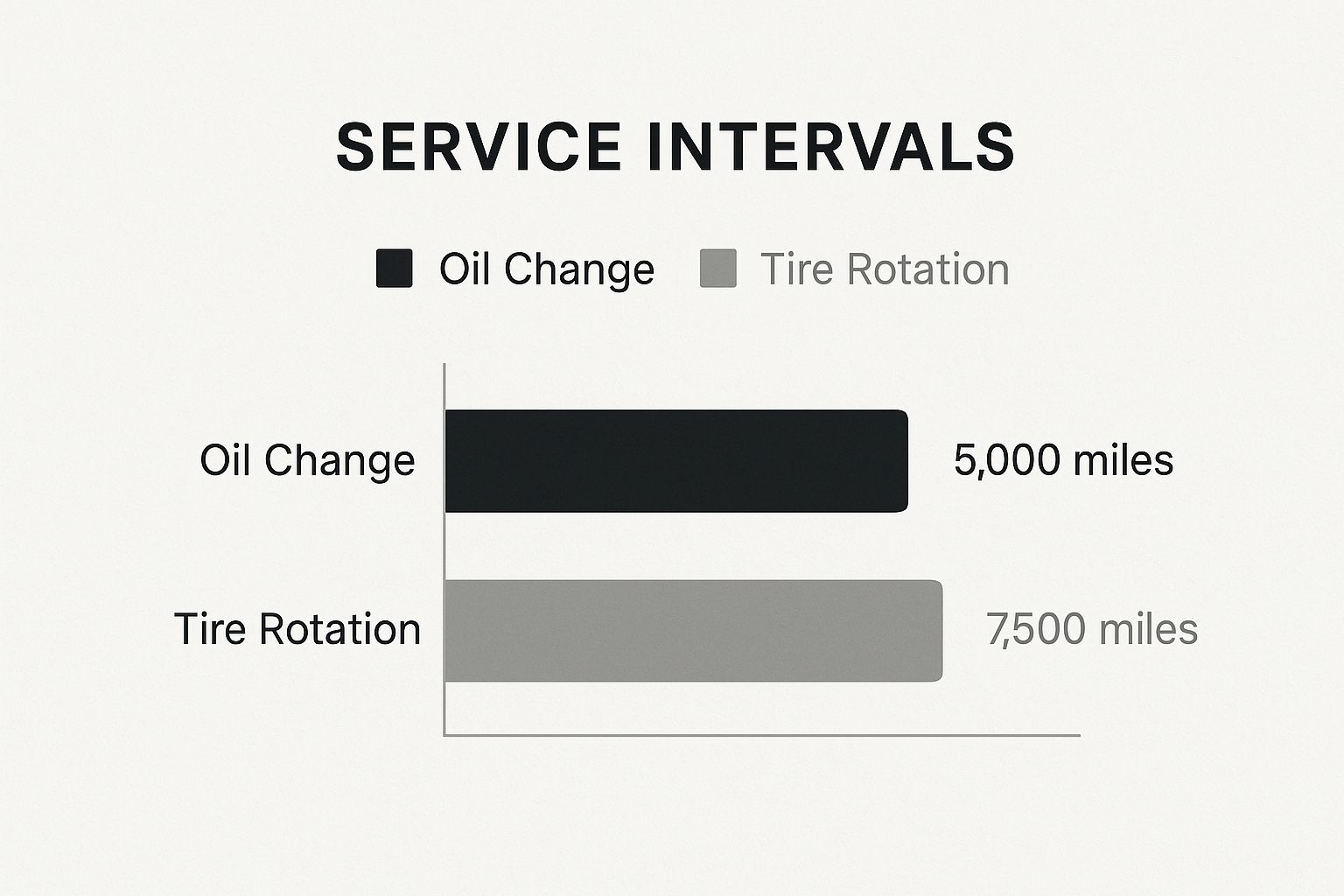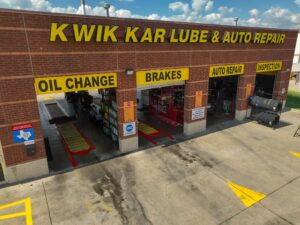Why Oil Changes and Tire Rotations Actually Matter

Regular oil changes and tire rotations are often overlooked, but they are vital for your car's well-being. These simple services are more than just routine checks; they are investments in your vehicle's longevity and performance. Think of them as preventative measures, like regular dental checkups, that protect your car from major problems down the road.
Protecting Your Engine's Heart
Oil is essential for your engine. It lubricates moving parts, minimizing friction and regulating temperature. Over time, oil degrades, losing its effectiveness and accumulating contaminants. This can lead to increased wear and tear on vital engine components.
Without proper lubrication, engine parts can grind against each other, potentially causing premature failure. Regular oil changes remove these contaminants and replenish the vital fluids, keeping your engine running smoothly. This proactive approach ensures efficient performance and extends the life of your engine.
The importance of preventative maintenance like oil changes is reflected in the growth of the oil change service sector. The global oil changes services market is projected to grow continuously from 2025-2033. Factors like the increasing use of synthetic motor oil and the demand for high-mileage oil contribute to this growth. The automotive aftermarket is also expanding, along with a greater emphasis on regular oil changes for preventive maintenance. The compound annual growth rate (CAGR) for the automotive engine oil market is estimated to be around 5.7%. Learn more about these statistics and market trends.
Ensuring Even Tire Wear and Optimal Performance
Tire rotations are just as important as oil changes for maintaining vehicle performance and safety. They ensure even wear across all four tires. Without rotations, tires wear unevenly, negatively affecting handling, traction, and fuel efficiency.
Front tires, which handle steering, typically wear faster than rear tires. Rotating your tires distributes this wear, extending their lifespan and optimizing vehicle performance. This simple practice enhances safety and improves your overall driving experience.
Extending the Life of Your Vehicle
Oil changes and tire rotations work together to protect your vehicle investment. By keeping your engine properly lubricated and ensuring even tire wear, you can prevent costly repairs. This translates to fewer breakdowns and a significantly longer lifespan for your car.
This proactive maintenance approach saves you money on repairs and boosts your car's resale value. Well-maintained vehicles are attractive to buyers, showcasing a history of responsible ownership and care.
Perfect Timing: When Your Vehicle Actually Needs Service

Maintaining your vehicle goes beyond simply remembering your oil change and tire rotation. Knowing when these services are truly necessary can prevent premature wear and tear, saving you money on future repairs. Let's ditch the old "3,000-mile" myth and discuss the best timing for your car's specific needs.
Decoding Your Vehicle's Needs
Modern vehicles have complex maintenance requirements. These needs depend on several factors, including your driving habits, the type of vehicle you own, and even the type of oil you use. For example, if you frequently tow heavy loads or drive in extreme weather, you'll need more frequent oil changes than someone with a short, easy commute.
The type of oil you choose also plays a significant role. Synthetic oils typically last longer than conventional oils, increasing the time between oil changes. This is a key factor when planning your maintenance schedule. Always check your owner's manual for specific recommendations.
Tire rotation frequency, too, depends on your driving style and vehicle type. A good rule of thumb, however, is to rotate your tires every 5,000 to 7,500 miles. This helps ensure even wear and extends the life of your tires.
To help illustrate the varying maintenance needs, let's take a look at this comparison:
Oil Change & Tire Rotation Recommended Intervals: A comparison of recommended maintenance intervals based on vehicle type, driving conditions, and oil type
| Vehicle Type | Oil Type | Driving Conditions | Oil Change Interval | Tire Rotation Interval |
|---|---|---|---|---|
| Sedan | Conventional | Normal | Every 3,000-5,000 miles | Every 6,000 miles |
| Sedan | Synthetic | Normal | Every 7,500-10,000 miles | Every 6,000 miles |
| Truck | Conventional | Heavy Towing | Every 3,000 miles | Every 5,000 miles |
| Truck | Synthetic | Heavy Towing | Every 5,000-7,500 miles | Every 5,000 miles |
| SUV | Conventional | Normal | Every 5,000 miles | Every 7,500 miles |
| SUV | Synthetic | Extreme Temperatures | Every 7,500 miles | Every 7,500 miles |
As you can see, the recommended intervals can vary quite a bit. Consulting your owner's manual and considering your specific driving situation will help you determine the best schedule for your vehicle.
Recognizing Warning Signs
Besides scheduled maintenance, it's crucial to recognize signs your car might need immediate attention. These can include unusual noises, vibrations, changes in performance, or fluid levels. Ignoring these warnings could lead to bigger, more expensive problems.
For instance, a sudden drop in fuel efficiency could signal a need for an oil change or a new air filter. Similarly, vibrations in the steering wheel might suggest you need a tire rotation or wheel balancing. Noticing these small cues can save you money and keep your car running smoothly.
Seasonal Considerations and Synchronizing Services
Seasonal changes impact your vehicle’s maintenance needs. Extreme temperatures, both hot and cold, put stress on engine components and tires. Preparing your vehicle for these changes with necessary maintenance before extreme weather hits is crucial. This might involve checking your tire pressure more frequently in winter or getting an oil change before a summer road trip.
Also, think about synchronizing your oil change and tire rotation. Doing these services together saves time and many auto shops offer combined packages, making it convenient and affordable.
Common Mistakes and How to Avoid Them
One common mistake drivers make is neglecting regular maintenance. Delaying or skipping oil changes and tire rotations can cause many problems, shortening your vehicle's life and leading to more frequent, costly repairs. By following your owner's manual's recommended maintenance schedule and addressing warning signs quickly, you can avoid these issues and keep your car running well for years to come. Proper maintenance is an investment in your car's longevity and your peace of mind.
Inside the Oil Change: What's Actually Happening

A proper oil change is more than just draining old oil. It involves essential inspections that can save you from expensive repairs down the road. These checks, usually performed by trained technicians, offer valuable insights into your engine's health.
The Importance of a Thorough Inspection
During a quality oil change, technicians look for signs of wear and tear, leaks, and other potential issues. They examine the oil filter, a vital part that removes contaminants, ensuring clean oil circulates through the engine. A clogged or damaged filter can significantly impact engine performance.
Technicians also inspect belts, hoses, and other crucial components for signs of damage. This proactive approach helps avoid unexpected breakdowns and keeps your car running longer.
Beyond the Basics: The Value of a Quality Oil Change
A cheap oil change might seem attractive, but it often skips the crucial inspection process. This can lead to unnoticed problems that worsen over time. Being aware of the facts about routine car maintenance is vital. You can learn about common oil change misconceptions.
For example, ignoring a small oil leak can eventually lead to major engine failure. A quality oil change, though potentially more expensive initially, can prevent these costly situations. Consider it a smart investment in your vehicle's long-term health.
The Right Oil for Your Vehicle
Different driving habits and vehicle types require different oil types. High-performance vehicles often need synthetic oil, offering better protection in extreme conditions. Selecting the correct oil viscosity is also essential.
Using an oil that's too thin or thick can reduce fuel efficiency and damage engine components. A qualified technician can advise on the best oil for your specific car.
The Growing Demand for Oil Changes
The automotive industry's growth directly impacts the need for services like oil changes. Globally, factors like the projected increase in oil demand (around 730 kb/d in 2025) correlate with rising vehicle sales and required maintenance. This is especially apparent in Asia, where growing economies like India and China are driving demand for transportation.
The global engine oil market is expected to grow from $43.47 billion in 2024 to $45.94 billion in 2025, highlighting the importance of this service. Find more detailed statistics here.
The Essential Role of the Oil Filter
The oil filter works with the oil to protect your engine. A high-quality filter effectively removes contaminants, keeping the oil clean and optimizing engine performance. In contrast, a cheap filter can allow these harmful particles to circulate, causing increased engine wear. Choosing a quality oil filter is just as critical as selecting the correct oil.
Understanding Your Dipstick and Oil Analysis Reports
Regularly checking your oil level with the dipstick is a simple yet effective way to monitor your engine. The dipstick shows both the oil level and its condition. Dark, gritty oil indicates you need an oil change.
Oil analysis reports, offered by some service centers, provide a more detailed look at your oil's condition, identifying potential problems before they worsen. This information helps you make informed choices about maintaining your vehicle.
Tire Rotation Mastery: Patterns That Maximize Performance

This bar chart illustrates the typical service intervals for both oil changes (5,000 miles) and tire rotations (7,500 miles). While these services are often addressed together, they operate on different schedules. Tracking each service independently is key to maximizing the lifespan of your engine and tires. For a better understanding of oil change costs, check out this guide on how much an oil change costs.
Tire rotation is a more nuanced process than just swapping tires around. It's a precise procedure that directly affects your car's handling, traction, and the overall life of your tires. This is particularly true with the variety of tire designs available today.
Understanding Tire Rotation Patterns
Different vehicles call for different rotation patterns. The most frequently used patterns include the forward cross, rearward cross, and X-pattern. Selecting the right pattern for your car depends on its drivetrain (front-wheel drive, rear-wheel drive, or all-wheel drive) and your tire type.
-
Forward Cross: In this pattern, front tires move straight to the rear, while rear tires shift diagonally to the opposite front positions. This pattern is often recommended for front-wheel-drive vehicles.
-
Rearward Cross: This is the reverse of the forward cross pattern. Rear tires move straight to the front, and front tires move diagonally to the opposite rear. This is often suitable for some rear-wheel-drive vehicles.
-
X-Pattern: Tires move diagonally from front to back and vice-versa, creating an "X" shape. This pattern can be a good option for some all-wheel-drive and four-wheel-drive vehicles.
To help visualize these patterns, let's look at the following table:
Tire Rotation Patterns by Vehicle Type
Visual representation of recommended tire rotation patterns for different drivetrain configurations
| Drivetrain Type | Recommended Pattern | Diagram | Special Considerations |
|---|---|---|---|
| Front-Wheel Drive | Forward Cross | Imagine an "X" where the front tires move straight back and the rear tires cross to the opposite front. | Often the default for FWD, check your owner's manual. |
| Rear-Wheel Drive | Rearward Cross | Imagine an "X" where the rear tires move straight forward and the front tires cross to the opposite rear. | Less common than Forward Cross, consult your owner's manual. |
| All-Wheel Drive/Four-Wheel Drive | X-Pattern | A simple "X" where each tire moves diagonally to the opposite end. | Can also use Forward Cross; check your owner's manual for specifics. |
| Four-Wheel Drive | X-Pattern or Forward Cross | Simple "X" or FWD-style | Consult your owner's manual |
This table provides a general guideline. Always consult your owner's manual for the specific recommendations for your vehicle.
Directional and Asymmetrical Tires
Modern tire technology introduces additional factors to consider when rotating tires. Directional tires are engineered to rotate in a single direction, which affects how they are rotated. These tires often have a "rotation" arrow marked on the sidewall. Asymmetrical tires, featuring different tread patterns on the inner and outer halves, need specific rotation methods to maintain optimal performance. Consult your owner’s manual or a tire professional for guidance on rotating these specialized tires.
The Benefits of Proper Tire Rotation
Proper tire rotation evenly distributes wear across all four tires. This has several benefits: maximizing tire lifespan, improving fuel efficiency by minimizing rolling resistance, and ensuring consistent handling and traction. It also helps prevent premature wear and tear on suspension components. For example, uneven wear can put extra stress on ball joints and tie rods.
Identifying Dangerous Wear Patterns
Tire rotation offers a valuable chance to inspect tires for damage or unusual wear. These patterns can signal alignment problems, suspension issues, or improper tire inflation. For instance, cupping, or uneven patches of wear, might indicate a suspension problem. Feathering, where one edge of the tread wears faster, often suggests an alignment issue. Addressing these problems early prevents further damage and maintains safe driving conditions. It also maximizes tire life and ensures consistent performance, providing an opportunity to catch potential safety hazards before they escalate. By maintaining proper tire rotation and addressing any unusual wear, you maximize tire lifespan and contribute to overall vehicle safety, reducing the risk of unexpected breakdowns and ensuring a smooth, safe ride.
DIY or Professional: Making the Right Choice for Your Situation
Deciding between handling your oil change and tire rotation yourself or taking your vehicle to a professional can be tricky. Several factors influence this decision, including your individual skills, available time, and the specific requirements of your car. This section will help you weigh the advantages and disadvantages of both approaches, allowing you to make an informed choice.
Evaluating The True Cost of DIY
While a DIY approach might seem cheaper initially, it's important to consider potential hidden costs. These include the expense of necessary tools, like a wrench set, an oil filter wrench, a jack, and jack stands. Don't forget the environmental responsibility of properly disposing of used oil and filters, which often comes with associated fees.
If you don’t already own these tools, the initial investment could easily surpass the cost of a professional oil change and tire rotation. Also, consider the value of your time. A DIY oil change and tire rotation can take several hours, especially if you're a beginner.
Vehicle Complexity: A Growing Concern
Modern vehicles are increasingly complex. Advanced engine designs and specialized tire technologies often require specific tools and a high level of expertise. Attempting to work on these systems without the proper knowledge can result in expensive mistakes.
Tasks that were once simple DIY projects for older vehicles may now demand specialized knowledge and equipment. Some modern cars, for example, have complicated undercarriage panels that must be removed, adding another layer of difficulty to the process.
Warranty Implications and Safety Risks
Incorrectly performed DIY maintenance could void your vehicle's warranty. Working under a car also presents inherent safety risks if proper precautions aren't followed. Securely lifting the vehicle and correctly disposing of hazardous materials are crucial.
An improperly secured car can slip off a jack, causing serious injury. Improper disposal of used motor oil can contaminate the environment.
Finding a Trustworthy Service Provider
If you opt for professional service, choosing a trustworthy provider is essential. Look for ASE-certified technicians, as they have demonstrated automotive repair expertise. A reputable shop will use quality parts and offer transparent pricing.
Here are some warning signs to watch out for:
- Pressure to Upsell: A good mechanic will recommend services based on your vehicle's needs, not sales quotas.
- Lack of Transparency: A trustworthy shop will clearly explain the work performed and provide a detailed invoice.
- Poor Communication: A reliable service provider will answer your questions thoroughly and keep you updated.
When choosing a shop, consider these questions:
- Are your technicians ASE-certified?
- What type of oil and filters do you use?
- Can you provide a written estimate?
- What is your warranty policy?
Asking the right questions and being aware of potential red flags will help you find a professional service provider who will take good care of your vehicle. At Kwik Kar Oil Change & Auto Care, we prioritize customer satisfaction with transparent pricing and high-quality services. Contact us today for all your oil change and tire rotation needs in Fort Worth.
Problems You'll Actually Prevent With Proper Maintenance
This section dives into the specific, often expensive, car problems that diligent maintenance, like regular oil changes and tire rotations, can prevent. We'll move beyond general advice and explore real-world examples, quantifying the potential cost savings of proactive car care.
Protecting Vital Engine Components
Regular oil changes are essential for protecting your engine's key components. Think of your engine as the heart of your car, and the oil as its lifeblood. Fresh, clean oil lubricates these moving parts, minimizing friction and preventing wear and tear. But over time, oil degrades, becoming less effective and accumulating contaminants.
For example, insufficient lubrication can drastically shorten the life of your turbocharger. Turbochargers operate under extreme conditions – high temperatures and speeds – and depend heavily on clean oil for cooling and lubrication. Without it, a turbocharger can overheat and fail, resulting in a repair bill potentially reaching thousands of dollars.
Similarly, the catalytic converter, a vital component of your vehicle's emissions system, can suffer damage from contaminated oil. Worn piston rings can allow oil to coat the catalytic converter, hindering its effectiveness and potentially requiring an expensive replacement. Regular oil changes help remove these contaminants, keeping your catalytic converter functioning correctly.
Preventing Premature Suspension Wear
Tire rotations are crucial for the health of your suspension system. Uneven tire wear can put excessive stress on suspension parts, leading to premature failure. For instance, if your front tires wear faster than the rear tires, it can impact your wheel alignment and strain components like your tie rods and ball joints.
Regular tire rotations distribute wear evenly across all tires, helping maintain proper wheel alignment. This, in turn, reduces stress on suspension components, extending their lifespan. It’s similar to rotating crops in a field – distributing the workload for even wear and tear. These repairs can add up, so regular rotations are a cost-effective preventative measure.
Quantifying the Cost Savings
The financial benefits of regular oil changes and tire rotations are significant. While these services require a small upfront cost, they can lead to substantial savings on major repairs in the future. A $50 oil change, for instance, could prevent a $5,000 engine rebuild resulting from neglected lubrication.
Moreover, regular maintenance reduces the likelihood of unexpected breakdowns, saving you the hassle and expense of towing and rental cars. This often-overlooked benefit of preventative maintenance can have a considerable financial impact, especially if you rely on your vehicle for work or daily life.
Boosting Resale Value
Detailed service records are a powerful tool for maximizing your vehicle's resale value. These records demonstrate a history of responsible car ownership and care, assuring potential buyers that the vehicle has been properly maintained. This can be a significant selling point, potentially justifying a higher asking price and a faster sale.
Early Warning Signs: Recognizing Potential Problems
Recognizing the early warning signs of potential car problems can save you significant time and money. Unusual noises, vibrations, or changes in your vehicle's performance can indicate developing issues. Addressing these promptly can prevent them from escalating into larger, more expensive repairs. For example, a grinding noise when braking could signal worn brake pads. Early attention to this can prevent damage to the rotors, saving you money on repairs.
For all your oil change and tire rotation needs in Fort Worth, visit Kwik Kar Oil Change & Auto Care. We provide dependable maintenance and expert repairs with integrity and transparency. Our certified technicians use high-quality parts and modern equipment to give your vehicle the care it deserves.
Article created using Outrank

